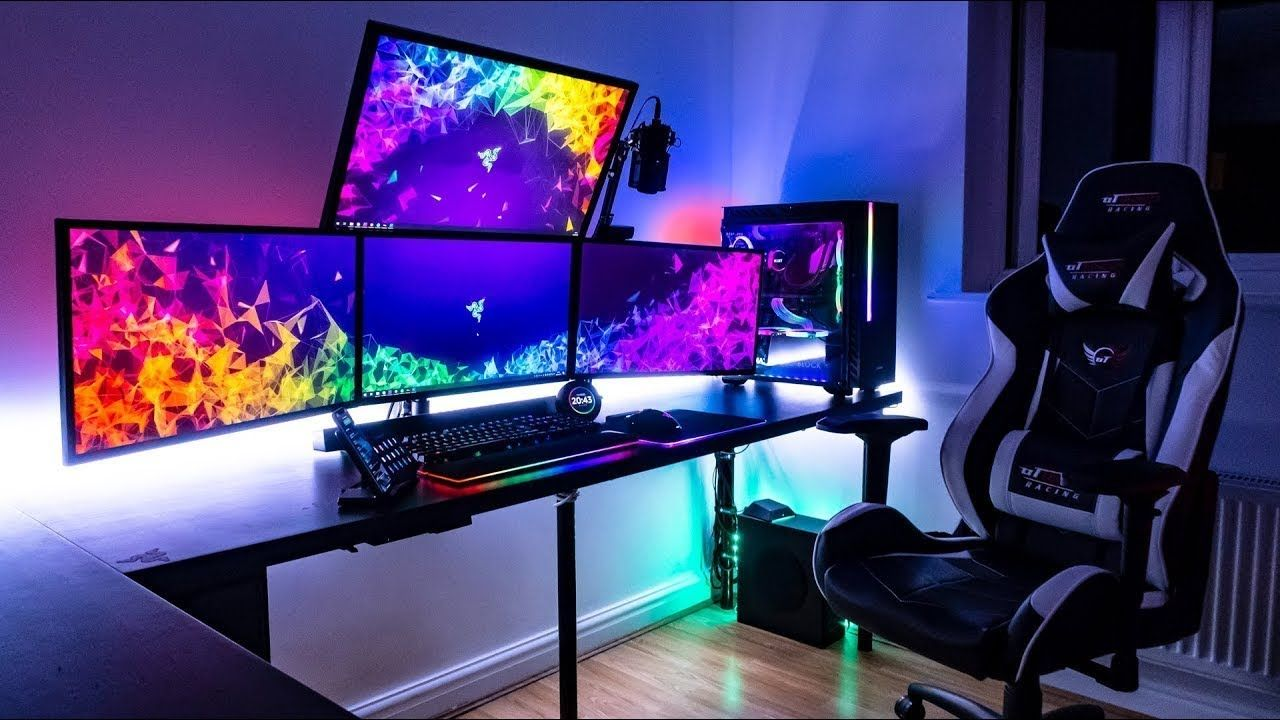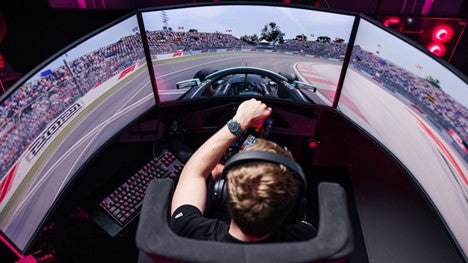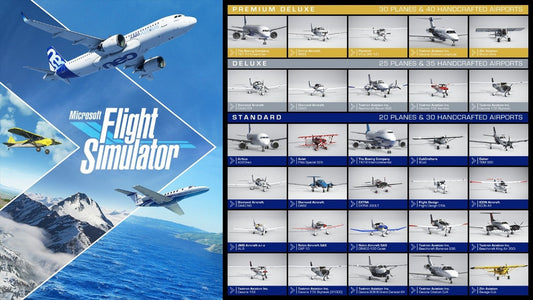The Best Monitors for Simulators

Figure 1: A High-End Multi-Monitor Gaming Setup
It doesn't matter if you have all the simulator components in the world; without a good monitor for your simulator, it won't work. You won't be fully immersed.
Samsung Odyssey G9

Figure 2: Samsung Odyssey G9
The Samsung Odyssey G9 stands out as the ultimate gaming monitor for gamers and simulation enthusiasts looking for one ultrawide experience. It boasts a 49-inch curved VA panel with a 32:9 aspect ratio. Think of this ultrawide panel as if three monitors were seamlessly connected side by side. This makes it one of the best gaming monitors for simulation games where peripheral vision is important.
Moreover, the Samsung Odyssey G9 runs on seamless, lag-free gaming with a 240Hz refresh rate and 1ms response time, while NVIDIA G-Sync and AMD FreeSync support ensures no screen tearing, either. Image quality features come in almost second to none. It has VESA DisplayHDR 1000 certification and 1000 peak brightness nits and 95% DCI-P3 color coverage, which means, as you'd assume, vivid colors, deep blacks, and excellent contrast.
When it comes to connectivity, this gaming monitor supports two DisplayPort 1.4 connections and one HDMI 2.0 for connection. It has an adjustable stand for height, tilt, and swivel; which allows room for personal ergonomic preferences.
However, the G9 comes at a premium price. Although the build is high gloss plastic, which means it makes the unit look expensive, it doesn't always make it feel or operate best with a more industrial-grade shell. The VA panel provides great quality images, but it won't be always as color-accurate as an IPS panel would reproduce.
Acer Predator XB271HK
Figure 3: Acer Predator XB271HK
Next on the list is the Acer Predator XB271HK. This is one of the best monitors for simulator games. A 27-inch ultra-adjustable device, Acer Predator XB271HK designed for the gamer who wants high-quality image renderings and easy gameplay for their sim setup. It has 4K UHD resolution with an IPS panel to provide clear images, crisp colors, and precise detail. Furthermore, the monitor comes with NVIDIA G-Sync technology, which allows the monitor's refresh rate to sync up with your GPU for non-stuttering or screen tearing gaming.
However, the refresh rate isn't any better with the XB271HK, only 60Hz if you're looking for faster frame rates. In the connection department, it's also challenged with 2 video connections: one DisplayPort 1.2 and one HDMI 1.4. It does have a few USB 3.0 connections for up and down streaming but they might not be enough.
Samsung Ultrawide CHG90
 Figure 4: Samsung Ultrawide CHG90
Figure 4: Samsung Ultrawide CHG90
If you can't afford an ultra-wide experience up to Odyssey G9 prices, the Samsung CHG90 is a fantastic ultrawide gaming monitor alternative. Featuring a 49-inch 32:9 aspect ratio 1800R curve, this monitor wraps around your vision nearly which is a sweet spot for simulation games like Asseto Corsa and Microsoft Flight Simulator 2024.
Equipped with a QLED VA panel and backed by HDR support, the CHG90 delivers vibrant and rich colors. While the monitor's 3840 x 1080 resolution support feels expansive, it also delivers sharp and crisp visuals for a streamlined experience. With a 144Hz refresh rate and AMD FreeSync 2 technology, it offers smooth, responsive performance that makes it one of the best gaming monitors currently available in the market.
Connectivity-wise, the CHG90 has two HDMI 2.0 inputs, one DisplayPort 1.4, Mini DisplayPort, two USB 3.0 ports, and audio jacks. The bezels are thin all around, with a slightly thicker bottom bezel that houses the Samsung logo. The only downside to size is that it takes up a lot of desktop real estate, which compromises a little on practicality for these more condensed setups.
Acer Predator CG7
 Figure 5: Acer Predator CG
Figure 5: Acer Predator CG
Continuing with the flow, we now introduce you to the Acer Predator CG7, a powerful 43-inch 4K monitor designed for gamers seeking a flat-screen display that combines size and performance in one powerful package.
Its VA panel delivers vivid visuals with deep blacks and a strong contrast ratio that makes it particularly suited for sim gaming. The screen is 4K UHD but can be downscaled to 1440p for optimal performance and features a 1ms response time with a 120Hz refresh rate (144Hz overclocked). It's gaming responsiveness at its best. Furthermore, all of this is compounded by G-Sync support, which reduces any screen tearing for in-game visuals. This makes it one of the best monitors for simulators.
In addition, the Predator CG7 is VESA Certified HDR1000, which not only boosts brightness and a spectrum of dynamics while gaming, but also renders even the most rendered worlds ghostly gorgeous. It has great connectivity, too. In that, it comes equipped with three HDMI 2.0 ports, two DisplayPort 1.4 ports, one USB-C port, traditional USB 2.0 and 3.0 ports, and one upstream USB.
While its size and features may tempt sim gamers to replace multi-monitor setups, CG7’s sheer scale demands adequate desk space. Also, when compared with IPS panels, the VA panels don’t offer as wide ultra-wide viewing angles. But for anyone interested in a massive, attention-grabbing 4K monitor for gaming that can also serve as a television for more laid-back activities, this is the one.
Lenovo G27c-10
 Figure 6: Lenovo G27c-10
Figure 6: Lenovo G27c-10
For budget gamers looking to get a curved screen immersive experience, the Lenovo G27c-10 is the way to go. This 27-inch 1500R curved VA panel is Full HD with a 165Hz refresh rate and 4ms response time.
The panel boasts a wide range of rich, vibrant colors as it supports 97% of the sRGB color gamut while the contrast ratio is 2500:1, meaning there are true blacks and excellent grayscale. The G27c-10 runs at a brightness level of 350 nits, which means it performs well in ultra-bright settings. Therefore, it's great for daytime sim racing or flighting.
One of the reasons the G27c-10 is one of the best gaming monitors is that it operates with both AMD FreeSync technology and G-Sync by NVIDIA. It functions seamlessly to reduce screen tearing and stuttering while in-game and works for all sim endeavors. Aesthetically, there's nothing to write home about, just a basic matte black finish that suits any business setting. The adjustment options include a tilt and height adjustment, and that's it. The connectivity features include one DisplayPort 1.2, one HDMI 2.0, and one 3.5mm audio.
Ultimately, though, for a fairly low-cost monitor, the Lenovo G27c-10 is ideal for the average gamer looking to compromise between cost and functionality, although the limited connectivity and adjustments might be off-putting.
AOC CU34G2X
 Figure 7: AOC CU34G2X
Figure 7: AOC CU34G2X
Coming next is the AOC CU34G2X, one of the best monitors for simulators in the ultrawide monitor market which comes with a three-year zero dead-pixel warranty. It offers a blend of performance and durability without relying on flashy marketing, it makes its pitch, and it does its job. It almost champions effectiveness and functionality.
The 34-inch frameless design has a QHD resolution of 3440 x 1440 with a 21:9 aspect ratio, composing everything required for simulation. The base design is metal, providing heft, keeping stability, and ensuring the monitor remains in place even if your work environment is on the smaller side.
The VA panel boasts a 144Hz refresh rate and a 1ms response time. 300 nits’ brightness with HDR capability for a clear image and sRGB coverage of 100%+ means highly saturated colors for lifelike images. Wide viewing angles and 8-bit color depth for quality and fidelity.
Connectivity is generous in AOC CU34G2X. It features two HDMI 2.0 ports, two DisplayPort 1.4 inputs, a headphone jack, and five USB 3.0 ports, one of which supports fast charging.
With such a balanced combination of specs and a reasonable price tag, the AOC CU34G2X is an all-rounder mid-sized ultrawide monitor. However, its moderate brightness and VA panel’s viewing angle limitations may not appeal to all users. Plus, its larger screen size requires additional desk space or a reliable mounting solution.
Dell S2719DGF

Figure 8: Dell S2719DGF
The Dell S2719DGF is a dependable flat gaming monitor—it's among the top picks for gaming monitors. This is a 27-inch display with QHD resolution of 2560 x 1440, so images are crisp without excessive detail for realistic simulation games. This is a TN panel, so this display offers a 144Hz refresh rate and 1ms response time, which means gameplay is incredibly fluid with a very low chance of motion blur. Moreover, input lag is low as well, meaning there's almost no delay. This makes it one of the best gaming monitors for competitive gamers.
The S2719DGF lacks contrast, however, with a native contrast ratio of 890:1 and no HDR support. It also features poor viewing angles which isn't surprising for a TN panel. On the flip side, it excels with gray and black uniformity. Plus, it has respectable reflection handling. The SDR color gamut is great, too, meaning bright and accurate colors which is good for gaming.
Now for the ports. Dell S2719DGF features two HDMI (2.0 & 1.4), one DisplayPort 1.2, four USB 3.0 Type-A, one USB 3.0 upstream, and two 3.5mm audio jacks (headphone, line-out). Though it is a solid low latency budget buy; yet for those seeking deeper colors with contrast, the below-average contrast ratio may not be enjoyable.
Final Thoughts
Whether you're a sim racer, pilot, or general enthusiast, choosing the right monitor can transform your simulation gaming experience. From budget options to ultrawide immersive displays, the monitors discussed above cater to a variety of preferences and setups. By aligning your needs with features like resolution, refresh rate, and panel type, you can find the ideal monitor that offers stunning visuals, smooth performance, and optimal connectivity for your simulator rig.






